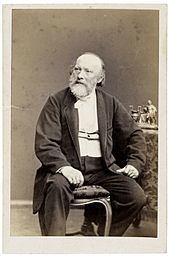Name Friedrich Drake | ||
 | ||
Died April 6, 1882, Berlin, Germany People also search for Heinrich Strack, Alexander Calandrelli | ||
Rundgang Alter St. Matthäus Kirchhof - 20. Station / Friedrich Drake
Friedrich Drake (June 23, 1805, Pyrmont – April 6, 1882, Berlin) was a German sculptor, best known for his huge memorial statues.
Contents

Biography
He was the son of a mechanic and served an apprenticeship as a turner in Minden, afterwards being employed in his father's workshop. While there, he made several clay models to amuse himself. A relative of Christian Daniel Rauch saw them and was impressed, so Drake was given a position in Rauch's Berlin studio.
His first major commission came in 1836. It was for a colossal statue of Justus Möser in the city of Osnabrück and paid his way for the traditional study trip to Italy. With a letter of recommendation from Rauch, he visited Bertel Thorvaldsen and presented him with engravings of his work. He returned to Berlin in 1837 and was appointed to the Prussian Academy of Arts. He quickly set up a workshop of his own, with his brothers Georg and Louis as assistants and his sister Karoline as the housekeeper. Karoline married the painter Friedrich Eduard Meyerheim and, in 1843, Drake married Lisette Schönherr, with whom he had six children.
In 1847, Drake was named a "Royal Professor" and, in 1863, he was awarded the Order of Merit of the Prussian Crown for Arts and Sciences. He became Vice-chancellor of the Academy in 1879. Using his experience as a trained mechanic, he invented a frame that enabled nude models to hold their poses.
During these years, his workshop was constantly busy producing sculptures of many well-known people, including a statue of Philipp Melanchthon in Wittenberg and one of Alexander von Humboldt in Philadelphia to mark the centenary of the Declaration of Independence. He married the Countess Marie of Waldeck in 1859, after his first wife's untimely death.
Works
He executed numerous statues and busts of famous figures, including Lorenz Oken, Leopold von Ranke, Otto von Bismarck and Helmuth von Moltke the Elder. Other works include:
